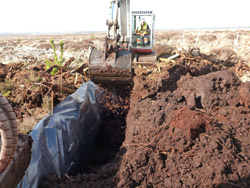Summary
Summary

This project aims to test two techniques for rewetting cracked peat bogs so that we can recommend how to do it in practice. Barriers to prevent water flowing away through cracks are formed by digging trenches deeper than the cracks and repacking them with peat with or without a plastic membrane lining one side of the trench.
Research objectives
- Scientific trials of a repacked trench and a membrane-lined repacked trench
- One trial on a lowland raised bog (Longbridge Muir) and one on a blanket bog (Dalchork)
- Technical evaluation of the operations
- Recommendations.
Results so far
- In both trials, we saw a dramatic rise in the water table (i.e. the level the water is at underground) after applying the treatments
- Both rewetting treatments raised the water table in the peat
- The blanket bog trial also had a third treatment – damming the plough furrows with peat – which was equally effective
- The repacked trench was quicker and cheaper to install than the membrane-lined repacked trench
- Summer 2018 water table lowest recorded – severe test for rewetting treatments.
Graphs: Longbridge Muir & Dalchork July 2018
Status
Lowland raised bog trial: completed October 2017
- Results paper in preparation due for submission in 2018.
Blanket bog trial: in progress
- Baseline monitoring October 2014 – June 2016
- Post-treatment monitoring June 2016 – October 2018
Contact
Funders and Partners
Core funding: Forestry Commission
Lowland bog trial: Scottish Natural Heritage co-funded the setting up of this project through a Peatland Action Grant. Forest Enterprise Scotland co-funded a technical evaluation of operational aspects.
Blanket bog trial: Forest Enterprise Scotland co-funded the setting up of the trial and Scottish Natural Heritage supplied water level loggers through the Peatland Action project.
Forestry Commission Policy
Forestry policy relating to peatland habitats was set down in 2000. It encouraged only limited restoration because evidence of benefits was lacking.
In 2014, supplementary guidance for Scotland stated a presumption to restore habitats in protected sites, those affecting connectivity of EU Habitats Directive Annex 1 habitats and those where deforestation would reduce net greenhouse gas emissions. Elsewhere, on sites insufficiently productive for tree growth to compensate for greenhouse gas losses from the soil, it recommends creating low-density, low-intensity, ‘peatland edge woodland’, which retains some woodland benefits but avoids a net carbon loss. ‘Deciding future management options for afforested deep peatland’ gives more information.
General Content
What’s of interest
New project: Carbon accumulation and loss in afforested peatlands
New book: Peatland Restoration and Ecosystem Services
